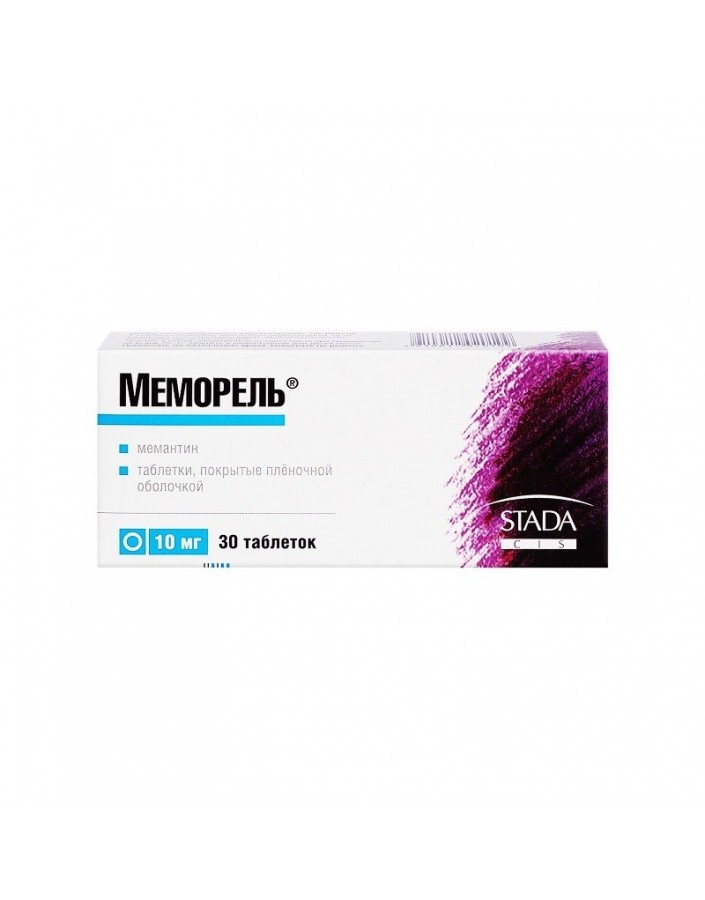




Security policy (edit with Customer reassurance module)

Delivery policy (edit with Customer reassurance module)

Return policy (edit with Customer reassurance module)
1 tablet, film coated, contains:
Active substance: Memantine hydrochloride - 10.00 mg
Excipients: lactose monohydrate - 192.5 mg, microcrystalline siliconized cellulose (36.75 mg - microcrystalline cellulose, colloidal silicon dioxide - 0.75 mg) - 37.50 mg, talc - 2.50 mg, Magnesium stearate - 2.50 mg.
The composition of the film shell: Opadry OY-S-28959 white (hypromellose (hydroxypropylmethyl cellulose) - 3.1250 mg, titanium dioxide - 1.5625 mg, triacetin - 0.3125 mg).
dementia treatment
It has nootropic, cerebrovasodilating, antihypoxic and psychostimulating action.
Adamantane derivative, by chemical structure and pharmacological properties similar to amantadine. It blocks glutamate N-methyl-D-aspartate (NMDA) receptors (including in the substantia nigra), thereby reducing the excessive stimulating effect of cortical glutamate neurons on neostriatum, which develops against the background of insufficient release of dopamine. Reducing the flow of ionized Calcium into neurons, reduces the possibility of their destruction. Mostly affects stiffness (rigidity and bradykinesia). In addition to the action on the central nervous system, memantine affects efferent innervation. Improves weakened memory, concentration, reduces fatigue and symptoms of depression, increases day-after-day activity.
After ingestion is rapidly and completely absorbed from the gastrointestinal tract. The maximum concentration is achieved through 3-8 hours. Food does not affect the absorption of the drug. A daily dose of 20 mg leads to an equilibrium plasma concentration of 70 to 150 ng / ml. The volume of distribution is about 10 l / kg. Communication with plasma proteins - 45%. In normal renal function, cumulation of memantine is not observed. 80% of memantine circulating in the blood is represented by a constant substance. Metabolism proceeds without cytochrome P450. The main metabolites are N-3,5-dimethylgludantan, an isomeric mixture of 4- and6-hydroxymemantin and 1-nitroso-3,5-dimethyladamantane. None of the metabolites has antagonistic activity against NMDA receptors. Excreted mainly by the kidneys.Withdrawal occurs in single phase, the half-life is 60-100 h, clearance is 170 ml / min / 1, 93 m2partially secreted by the renal tubules. With alkaline urine, drug excretion slows down (on average, 80% with urine pH 8).
Dementia is moderate to severe in Alzheimer's disease.
Hypersensitivity to the components of the drug, severe liver failure, lactose intolerance, lactase deficiency, glucose-galactose malabsorption syndrome (the drug contains lactose), pregnancy, breastfeeding, age up to 18 years.
with caution prescribed for thyrotoxicosis, epilepsy, convulsions (including history), with simultaneous use of NMDA receptor antagonists (amantadine, ketamine, dextromethorphan), in the presence of factors that increase the pH of the urine (abrupt diet change, abundant intake of alkaline gastric buffers), with severe urinary tract infections, with myocardial infarction (in history), heart failure III-IV functional class (according to the NYHA classification), uncontrolled arterial hypertension, in renal failure, liver failure.
Memantine has the ability to slow the development of the fetus.
At the time of treatment with memantine, breastfeeding should be interrupted.
The drug is taken orally, regardless of the meal.
During the first week, the daily dose is 5 mg (in the morning). During the second week, the daily dose is 10 mg (5 mg 2 times / day). During the third week, the daily dose is 15 mg / day (10 mg in the morning and 5 mg in the evening). From the fourth week the daily dose is 20 mg / day. The maximum daily dose of 20 mg / day.
Dose adjustment in elderly patients (over 65 years) is not required.
With moderate renal failure (creatinine clearance 50-80 ml / min) correction doses usually not required; with creatinine clearance 30-49 ml / min daily the dose initially does not exceed 10 mg, then after 7 days, provided the tolerance is good, the dose can be increased up to 20 mg. In severe renal failure (creatinine clearance 5-29 ml / min) daily dose should not exceed 10 mg.
With mild and moderate liver failure (class A and B according to the Child-Pugh classification), dose adjustment is not required.
Nervous system: dizziness, headache, drowsiness, gait disturbance, confusion, hallucinations, convulsions, psychosis, irritability.
From the gastrointestinal tract: constipation, vomiting, pancreatitis, nausea.
Infections and invasions: fungal infections.
Cardiovascular: increased blood pressure, venous thrombosis, thromboembolism.
On the part of the body as a whole: general weakness, fatigue, allergic reactions.
Symptoms: dizziness, tremor, agitation, drowsiness, dullness, agitation, stupor, convulsions, aggression, hallucinations, gait imbalance, vomiting, diarrhea.
Treatment: gastric lavage, the appointment of Activated carbon; symptomatic therapy. There is no specific antidote. Removal of the drug can be accelerated by acidifying the urine.
With simultaneous use can weaken the effect of barbiturates and neuroleptics.
The action of Baclofen and dantrolene may change under the influence of memantine, therefore, it may be necessary to adjust their doses.
With simultaneous use of memantine with levodopa preparations, dopamine agonists, anticholinergic agents, the action of the latter can be enhanced.
Due to the fact that memantine and amantadine are NMDA receptor antagonists, simultaneous use should be avoided due to the risk of developing toxic effects. Combinations of memantine with ketamine, dextromethorphan, and phenytoin are also potentially toxic.
For the transport of amantadine, zimetidine, Ranitidine, quinidine, procainamide, quinine, and nicotine, the same renal cationic system is used in the body, which may cause the interaction of these drugs with memantine, leading to an increase in its plasma concentration.
With simultaneous use of memantine may cause a decrease in the concentration of hydrochlorothiazide in the serum.
When applied simultaneously with Warfarin and other indirect anticoagulants, careful monitoring of prothrombin time and international normalized ratio is required.
With alkaline urine, more careful monitoring of patients is required due to slowing down of the release of memantine.
Influence on ability to drive motor transport and control mechanisms. Care should be taken when driving and performing work that require high concentration of attention.
In a dry, dark place at a temperature not higher than 25 degrees. Keep out of the reach of children.